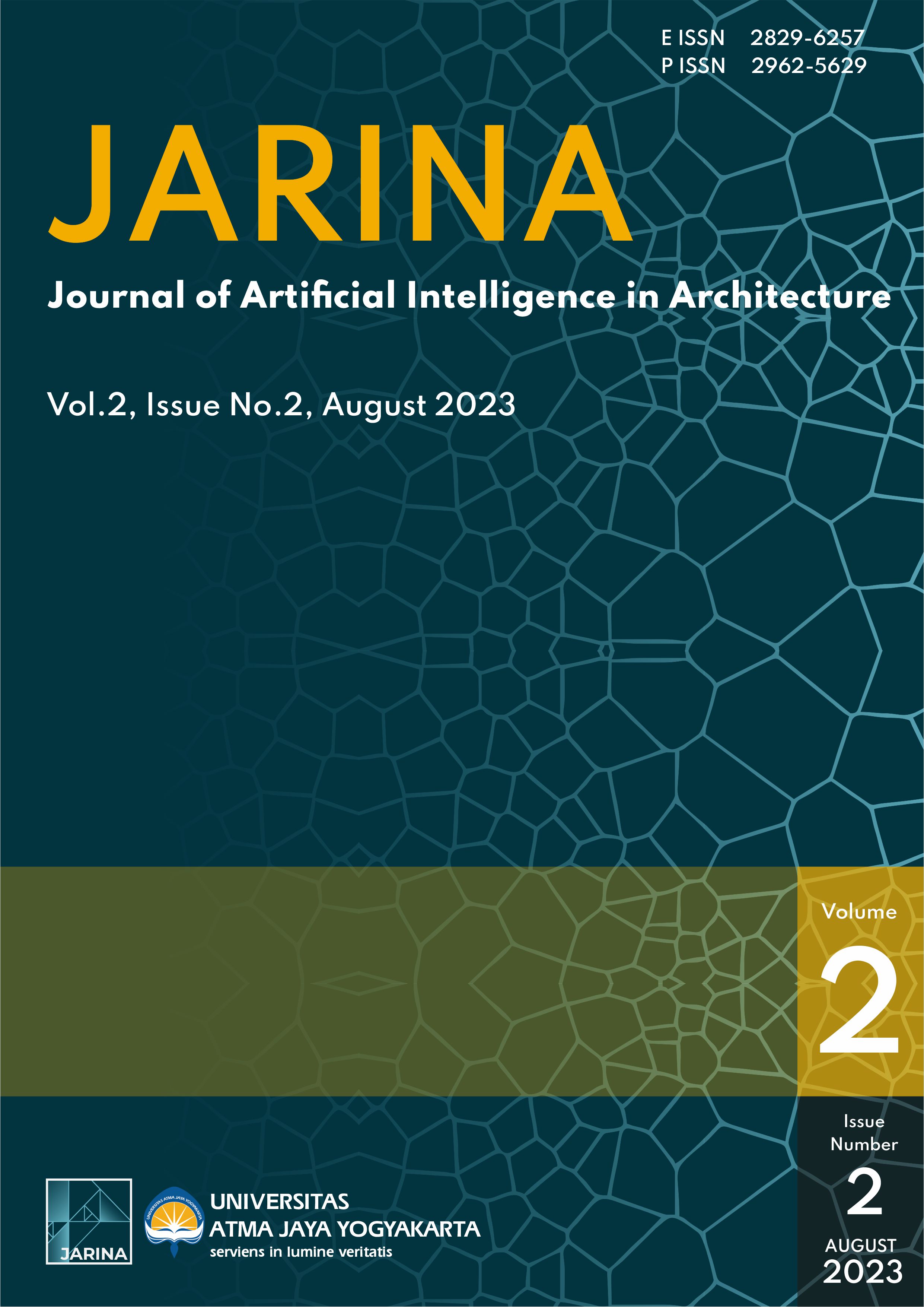Passive Window Energy Performance in Buildings: Modeling of Apartment Buildings in Indonesia
DOI:
https://doi.org/10.24002/jarina.v2i2.6729Keywords:
EnergyPlus, Passive windows , Thermochromic, Double-glazing, ApartmentAbstract
Along with urban growth in urban areas and energy consumption, which continues to increase every year, the selection of windows in the initial design is essential to obtain buildings that are not energy intensive. Selecting the correct window in the blueprint design reduces building energy consumption. Smart windows, especially thermochromic windows, are one of the most promising window technologies because they are the most economical and have passive control with zero energy input, which holds good promise for energy-saving applications. Apart from that, double-glazing windows are also frequently used in energy-saving applications. Therefore, a study compared the energy-saving potential of thermochromic and double-glazing windows to clear glass windows, using computer modeling through EnergyPlus, in high-rise apartment buildings in cities throughout Indonesia's diverse climates. From the modeling results, total energy consumption can be reduced by around 8.91% to 10.96% of total building energy consumption by replacing the conventional clear glass with double-glazing windows or more able to reduce about 20.22% to 24.19% by replacing the conventional clear glass with thermochromic windows. Furthermore, this potential varies depending on geometric shapes, materials, building facades, local climate, and building orientation. Nevertheless, considering the potential benefits, these windows are highly suitable for application in buildings seeking to reduce their energy consumption and improve energy efficiency.
References
M. Santamouris and K. Vasilakopoulou, “Present and future energy consumption of buildings: Challenges and opportunities towards decarbonisation,” e-Prime - Advances in Electrical Engineering, Electronics and Energy, vol. 1, p. 100002, 2021.
B. Güneralp, M. Reba, B. U. Hales, E. A. Wentz, and K. C. Seto, “Trends in urban land expansion, density, and land transitions from 1970 to 2010: a global synthesis,” Environ. Res. Lett., vol. 15, no. 4, p. 044015, Apr. 2020, doi: 10.1088/1748-9326/ab6669.
“Work Report of the Directorate of Flats,” Ministry of Public Works and Public Housing of Republic of Indonesia, 2020. Accessed: Sep. 06, 2022. [Online]. Available: https://perumahan.pu.go.id/storage/renstra/LaKIP_Direktorat_Rusun_Tahun_2020.pdf
S. E. Bibri, J. Krogstie, and M. Kärrholm, “Compact city planning and development: Emerging practices and strategies for achieving the goals of sustainability,” Developments in the Built Environment, vol. 4, p. 100021, Nov. 2020, doi: 10.1016/j.dibe.2020.100021.
C. Li, L. Sun, and P. Jones, “Liveability of High-rise Housing Estates: A Resident-centered High-Rise Residential Environment Evaluation in Tianjin, China,” p. 14, 2012.
United Nations Environment Programme and Global Alliance for Buildings and Construction, 2020 Global Status Report for Buildings and Construction: Towards a Zero-emissions, Efficient and Resilient Buildings and Construction Sector - Executive Summary. 2020.
W. W. Che et al., “Energy consumption, indoor thermal comfort and air quality in a commercial office with retrofitted heat, ventilation and air conditioning (HVAC) system,” Energy and Buildings, vol. 201, pp. 202–215, Oct. 2019, doi: 10.1016/j.enbuild.2019.06.029.
K. J. Chua, S. K. Chou, W. M. Yang, and J. Yan, “Achieving better energy-efficient air conditioning – A review of technologies and strategies,” Applied Energy, vol. 104, pp. 87–104, Apr. 2013, doi: 10.1016/j.apenergy.2012.10.037.
N. Al-Tamimi, “Passive Design Strategies for Energy Efficient Buildings in the Arabian Desert,” Frontiers in Built Environment, vol. 7, no. 805603, pp. 1–11, 2022.
S. C. Nunes et al., “Sustainable Dual-Mode Smart Windows for Energy-Efficient Buildings,” ACS Appl. Energy Mater., vol. 2, no. 3, pp. 1951–1960, 2019.
Z. Djamel and Z. Noureddine, “The Impact of Window Configuration on the Overall Building Energy Consumption under Specific Climate Conditions,” Energy Procedia, vol. 115, pp. 162–172, Jun. 2017, doi: 10.1016/j.egypro.2017.05.016.
A. Cannavale, U. Ayr, F. Fiorito, and F. Martellotta, “Smart Electrochromic Windows to Enhance Building Energy Efficiency and Visual Comfort,” Energies, vol. 13, no. 6, p. 1449, Mar. 2020.
M. Casini, “Smart windows for energy efficiency of buildings,” in Proc. of the Second Intl. Conf. on Advances In Civil, Structural and Environmental Engineering- ACSEE 2014, 2014, p. 10.
Y. Ke et al., “Smart Windows: Electro‐, Thermo‐, Mechano‐, Photochromics, and Beyond,” Adv. Energy Mater., p. 38, 2019.
R. Tällberg, B. P. Jelle, R. Loonen, T. Gao, and M. Hamdy, “Comparison of the energy saving potential of adaptive and controllable smart windows: A state-of-the-art review and simulation studies of thermochromic, photochromic and electrochromic technologies,” Solar Energy Materials and Solar Cells, vol. 200, p. 109828, Sep. 2019, doi: 10.1016/j.solmat.2019.02.041.
X. Wang and S. Narayan, “Thermochromic Materials for Smart Windows: A State-of-Art Review,” Frontiers in Energy Research, vol. 9, 2021, Accessed: Mar. 02, 2022. [Online]. Available: https://www.frontiersin.org/article/10.3389/fenrg.2021.800382
M. Brzezicki, “A Systematic Review of the Most Recent Concepts in Smart Windows Technologies with a Focus on Electrochromics,” Sustainability, vol. 13, no. 17, Art. no. 17, Jan. 2021, doi: 10.3390/su13179604.
M. Aburas, V. Soebarto, T. Williamson, R. Liang, H. Ebendorff-Heidepriem, and Y. Wu, “Thermochromic smart window technologies for building application: A review,” Applied Energy, vol. 255, p. 113522, Dec. 2019, doi: 10.1016/j.apenergy.2019.113522.
A. A. Butt et al., “Investigating the energy saving potential of thermochromic coatings on building envelopes,” Applied Energy, vol. 291, p. 116788, Jun. 2021, doi: 10.1016/j.apenergy.2021.116788.
Y. Ke et al., “Adaptive Thermochromic Windows from Active Plasmonic Elastomers,” Joule, vol. 3, no. 3, pp. 858–871, Mar. 2019, doi: 10.1016/j.joule.2018.12.024.
S. Hoffmann, E. S. Lee, and C. Clavero, “Examination of the technical potential of near-infrared switching thermochromic windows for commercial building applications,” Solar Energy Materials and Solar Cells, vol. 123, pp. 65–80, Apr. 2014, doi: 10.1016/j.solmat.2013.12.017.
L. Long and H. Ye, “How to be smart and energy efficient: A general discussion on thermochromic windows,” Sci Rep, vol. 4, no. 1, p. 6427, Sep. 2014, doi: 10.1038/srep06427.
S. Liu et al., “Bioinspired thermochromic transparent hydrogel wood with advanced optical regulation abilities and mechanical properties for windows,” Applied Energy, vol. 297, p. 117207, 2021.
S. Wang, Y. Zhou, T. Jiang, R. Yang, G. Tan, and Y. Long, “Thermochromic smart windows with highly regulated radiative cooling and solar transmission,” Nano Energy, vol. 89, p. 106440, Nov. 2021, doi: 10.1016/j.nanoen.2021.106440.
S. Liu, Y. Li, Y. Wang, K. M. Yu, B. Huang, and C. Y. Tso, “Near-Infrared-Activated Thermochromic Perovskite Smart Windows,” Advanced Science, vol. 9, no. 14, p. 2106090, 2022, doi: 10.1002/advs.202106090.
R. Zhang et al., “Energy-Efficient Smart Window Based on Thermochromic Hydrogel with Ultrahigh Visible Transparency and Unprecedented Infrared Transmittance Modulation.” Mar. 03, 2022. doi: 10.21203/rs.3.rs-134267/v1.
Z. Rashidzadeh and N. Heidari Matin, “A Comparative Study on Smart Windows Focusing on Climate-Based Energy Performance and Users’ Comfort Attributes,” Sustainability, vol. 15, no. 3, Art. no. 3, Jan. 2023, doi: 10.3390/su15032294.
Md. Washim Akram, Muhammad Firdaus Mohd Zublie, Md. Hasanuzzaman, and Nasrudin Abd Rahim, “Global Prospects, Advance Technologies and Policies of Energy-Saving and Sustainable Building Systems: A Review,” Sustainability, vol. 14, pp. 1–27, doi: . https://doi.org/10.3390/su14031316.
J. Yang, Z. Xu, H. Ye, X. Xu, X. Wu, and J. Wang, “Performance analyses of building energy on phase transition processes of VO2 windows with an improved model,” Applied Energy, vol. 159, pp. 502–508, Dec. 2015, doi: 10.1016/j.apenergy.2015.08.130.
Metro Performance Glass, “Windows Specfiing, H1, R Value, U Value, new zealand, climate zone,” Metro Performance Glass New Zealand, 2022. https://www.metroglass.co.nz/window-glazing/window-specifying-new-homes-and-housing/ (accessed Sep. 25, 2022).
National Glass, “Glass Performance Data.” 2019. Accessed: Sep. 25, 2022. [Online]. Available: https://www.nationalglass.com.au/wp-content/uploads/2019/06/Glass-Data_v4-Low-Res.pdf
K. Khaled, U. Berardi, and Z. Liao, “Energy modelling and saving potential of polymeric solar-responsive thermochromic window films,” Solar Energy, vol. 244, pp. 84–103, Sep. 2022, doi: 10.1016/j.solener.2022.08.008.
F. Favoino, “Simulating switchable glazing with EnergyPlus: an empirical validation and calibration of a thermotropic glazing model,” presented at the Building Simulation and Optimization, International Building Performance Simulation Association, Dec. 2015.
M. Oh, S. Tae, and S. Hwang, “Analysis of Heating and Cooling Loads of Electrochromic Glazing in High-Rise Residential Buildings in South Korea,” Sustainability, vol. 10, no. 4, Art. no. 4, Apr. 2018, doi: 10.3390/su10041121.
F. Isaia, M. Fiorentini, V. Serra, and A. Capozzoli, “Enhancing energy efficiency and comfort in buildings through model predictive control for dynamic façades with electrochromic glazing,” Journal of Building Engineering, vol. 43, p. 102535, Nov. 2021, doi: 10.1016/j.jobe.2021.102535.
Office of Energy Efficiency and Renewable Energy, U.S. Department of Energy, “Prototype Building Models.” https://www.energycodes.gov/prototype-building-models (accessed Mar. 27, 2023).
D.B. Crawley and L.K. Lawrie, “Climate One Building: Southwest_Pacific,” 2022. https://climate.onebuilding.org/WMO_Region_5_Southwest_Pacific/IDN_Indonesia/index.html (accessed Feb. 25, 2022).

Downloads
Published
How to Cite
Issue
Section
License
Copyright (c) 2023 Laurentius Kevin Hendinata, Nur Abdillah Siddiq, Ahmad Ilham Rokhul Fikri, Michael Alfano Suprapto, Ribka Prilia

This work is licensed under a Creative Commons Attribution 4.0 International License.
Authors who publish with this journal agree to the following terms:
1.Authors retain copyright and grant the journal right of first publication with the work simultaneously licensed under a Creative Commons that allows others to share the work with an acknowledgement of the work's authorship and initial publication in this journal.
2.Authors are able to enter into separate, additional contractual arrangements for the non-exclusive distribution of the journal's published version of the work (e.g., post it to an institutional repository or publish it in a book), with an acknowledgement of its initial publication in this journal.
3.Authors are permitted and encouraged to post their work online (e.g., in institutional repositories or on their website) prior to and during the submission process, as it can lead to productive exchanges, as well as earlier and greater citation of published work (See The Effect of Open Access).
















